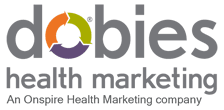Top 5 Healthcare Marketing Trends to Watch in 2019
 When asked about their top concerns for 2019, most healthcare executives say they need innovative ways to connect with consumers, demonstrate value, use data effectively and keep people healthy. In response, many thought leaders are publishing predictions for 2019 in healthcare and healthcare marketing.
When asked about their top concerns for 2019, most healthcare executives say they need innovative ways to connect with consumers, demonstrate value, use data effectively and keep people healthy. In response, many thought leaders are publishing predictions for 2019 in healthcare and healthcare marketing.
I know what you’re thinking: So many lists but so little time, right? As executives, we love to read, but it can be difficult to find actionable information in a sea of trends and predictions. That’s why I’ve taken time to dive deep into the issue and emerge with what I see as the top five trends to watch in healthcare marketing for 2019:
- The deliberate and intentional use of data: Using data to drive decisions is a top theme in all aspects of healthcare marketing. It includes the strategic use of predictive data and analytics to identify consumer intent (what they plan to do or buy) and impact the resulting action. Along the same lines is the use of artificial intelligence (AI), which can sort through huge volumes of data to monitor consumer activity and pinpoint trends that marketers can quickly act upon. AI is in position to help transform healthcare in the same way, by perusing data patterns to identify possible health risks ahead of time. This allows for a greater emphasis on prevention, minimizing costs, and better patient outcomes.
- Personalized experience: As stated by Ad Age, “People still crave meaning and connection more than ever.” Consumers respond to relevant, relatable, authentic content that feels as if it were created just for them. This is another way data can drive our thinking, our communication and our creative content, so we are executing targeted marketing strategies that offer a better user experience. And we are seeing new ways to customize through voice search, web applications, chatbots and video – all high-performing trends for more personal communication.
- Brand culture: Healthcare employees are joining consumers in searching for an authentic brand culture – a company’s core values, practices and behaviors – that they can align with and support. Such a culture promotes a human focus, offers a positive experience, and conveys overall health and wellness. It also provides innovative services that are convenient (e.g., outpatient expansion and retail locations) and accessible (e.g., telehealth and virtual care). A branded culture is engaging and meaningful, and it provides a purpose-driven connection, not just a bottom line.
- Attainable well-being: The focal point here is on keeping people healthy versus simply treating illness. We call this the lifecare model. Lifecare is about inspiring and supporting decisions that encourage healthy lives, which involves putting the consumer at the center and collaborating with community partners to encourage and deliver better health beyond traditional methods. We see this in the rise of population health management, value-based care, consumerism, preventive health through wearables, fitness, nutrition, and the emphasis on strategic partnerships that expand access to health across communities. Our efforts should concentrate on making health a lifetime consumer goal, while still addressing acute and chronic healthcare issues where needed.
- Agile marketing: Agile marketing is data-validated, customer-focused, highly collaborative and quickly adaptive to continuous change. “Agile” is a term that has traditionally been associated with software development, but it’s building momentum in all industries for achieving higher productivity, innovation and alignment with multiple teams. According to AgileSherpas’ State of Agile Marketing Report, nearly two-thirds (61%) of traditional marketing teams report plans to start an Agile implementation within the next 12 months.
The link among all these trends is the strategic intent on which they are based. All themes are deliberate, authentic, thoughtful and targeted. Mass communication will not deliver the same results. As consumers become savvier and start to demand relationships over transactions, our healthcare marketing efforts should follow suit.
At Dobies Health Marketing, a strategy-first healthcare marketing firm, strategy is part of our company ethos. It is a practice embedded in everything we do, the way we think and the actions we take. As the framework for making better business decisions for ourselves and our clients, it is a deliberate, data-driven process by which we jointly define business goals and develop the road map for achieving them.
For more information on strategy-first marketing for healthcare, contact Dobies Health Marketing.
Reader Tip: To read more current industry trends, I recommend downloading “Healthcare Trends 2019.” This Healthcare Leadership Intelligence Report from B.E. Smith presents key findings on influential trends from a survey of hundreds of healthcare executives. Survey topics included Industry Directions, Career Factors, Talent Management and Leadership.
About the Author
 Julie Amor, MHA, President and Chief Strategy Officer for Dobies Health Marketing, has 30 years of experience elevating healthcare brands. Share your thoughts with her by tweeting @DobiesGroup, connecting with us on LinkedIn, or by commenting on our Facebook page.
Julie Amor, MHA, President and Chief Strategy Officer for Dobies Health Marketing, has 30 years of experience elevating healthcare brands. Share your thoughts with her by tweeting @DobiesGroup, connecting with us on LinkedIn, or by commenting on our Facebook page.




